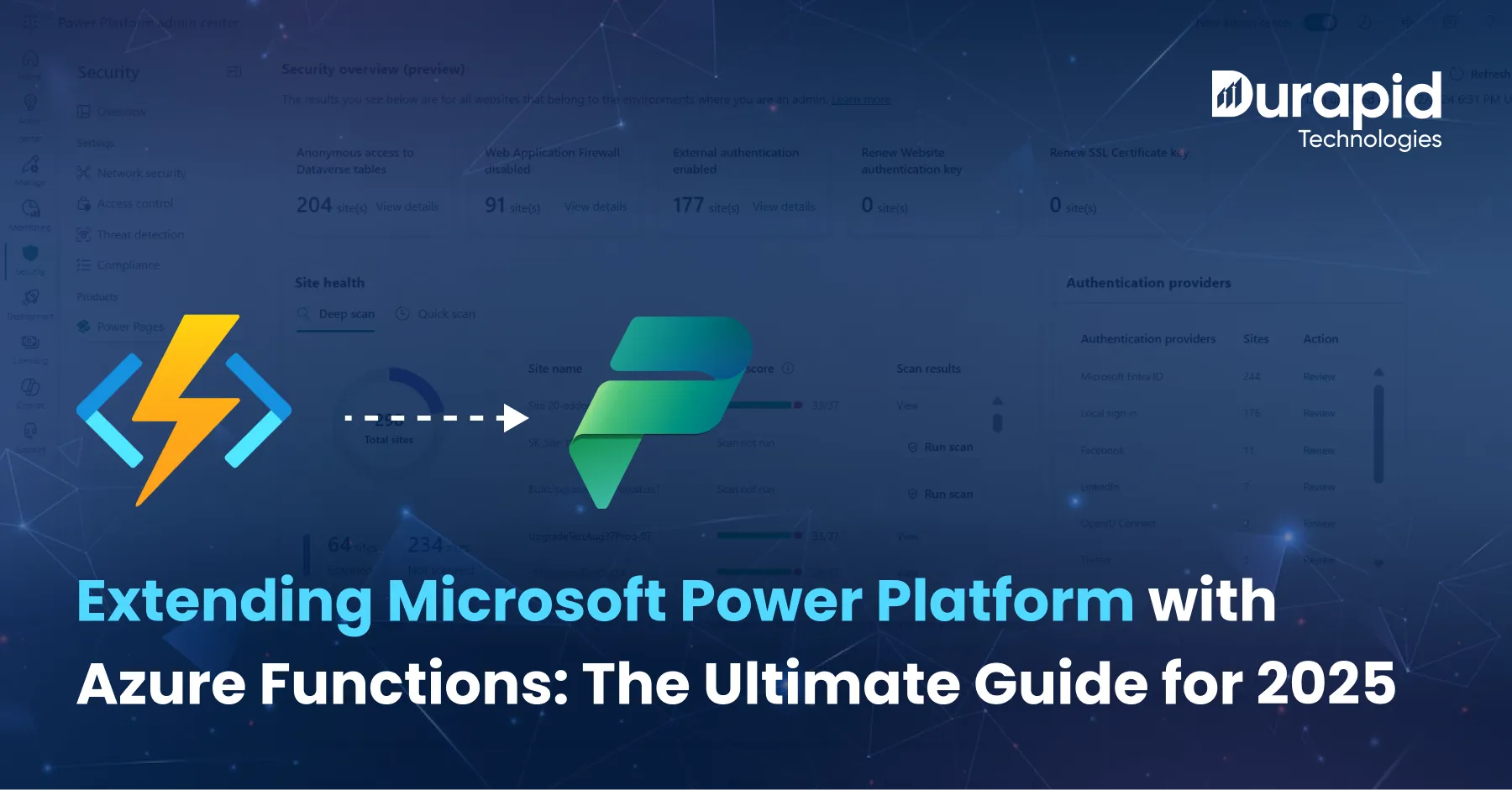Extending Microsoft Power Platform with Azure Functions: The Ultimate Guide for 2025

Introduction: Why Azure Function Integration Is Becoming the Secret Sauce of Low-Code Success
You know that feeling when you’ve finally assembled your dream productivity toolkit, but there’s still this nagging feature your business workflow needs? Welcome to the developer’s daily groundhog day. Whether you’re building apps, automating processes, or scaling data pipelines, the gap between what’s possible and what’s practical is shrinking,thanks to the unstoppable rise of azure function integration.
Today, the digital transformation battleground isn’t just about code vs. no code, it’s about low-code platforms with plug-and-play power for custom logic, scalability, security, and pure creative freedom. If you’re in IT, product management, or engineering, it’s time to look beyond the drag-drop: let’s supercharge your Microsoft Power Platform world with Azure Functions and make magic happen.
What’s the Hype? Power Platform, Serverless, and the Cloud-First Imperative
Let’s get real: enterprise IT is evolving at warp speed. Clients want bespoke portals, automations, insights, and integrations, yesterday. Low-code is great, but what happens when you hit its limits? Azure Functions, the Swiss Army knife of cloud-native development, unlocks next-level flexibility and speed.
Serverless computing is changing the game. There are no servers to manage, no VMs to update. Your code scales on-demand, runs when you need it, and costs only when used. That’s more brainspace for innovation and less for maintenance.
The Power Platform + Azure Functions Combo: What Do You Actually Get?

- Native extensibility: Use Azure Functions to run C#, Python, JavaScript… whatever your business logic demands.
- Infinite integrations: Connect to anything, APIs, databases, custom systems, inside and outside Microsoft’s ecosystem.
- Ultra-fast scaling: Handle spikes, automate bursting workloads, support millions of users.
- Secure cloud endpoints: Enforce Azure Active Directory, API keys, and truly enterprise-class controls.
What does this mean for you? You build smarter, automate deeper, and deliver new digital experiences, without ever having to say “Sorry, the platform can’t do that.”
Industry Context: The (Painful) Reality of Enterprise Automation
- “Can I call an external weather API from my Power App?”
- “How do I manipulate data beyond what Power Automate’s connectors can do?”
- “We need to run advanced validation, batch processing, invoice generation, custom reporting, without blowing our IT budget!”
Sound familiar? Enterprise integration strategies are no longer a buzzword; every business leader wants agility, without technical debt. The talent war for full-stack developers is real, deadlines are yesterday. That’s why Azure Function integration’s ability to bridge these gaps, securely, scalably, and affordably, is a game-changer.
Strategic Solution: When (and Why) Should You Extend Power Platform with Azure Functions?
Let’s face it, even the robust built-in Microsoft Power Platform services can’t do everything. Here’s where Azure Functions shine:

- Business logic that’s too complex for Power Fx or simple flows, think tax calculations, randomization, on-the-fly PDF or Excel generation, image transformations.
- Integrating with legacy backends: On-prem databases, ERPs, or esoteric industry apps? Custom APIs via Azure Function are your best friends.
- Massive, bursty workloads: Got a quarterly batch that chews millions of records? Offload to Azure Functions and sleep easy.
- Cross-cloud and hybrid app scenarios: Bridge clouds, add advanced integrations, and play nicely with all your partners’ data.
The result? Power Apps and Power Automate stay lightweight, your team stays productive, and your IT architects finally sleep at night.
Technical Deep Dive: How Azure Functions Supercharge the Power Platform
Let’s get techy, but keep it crisp and human so your inner developer, or that business user with big energy, doesn’t snooze off.
1. Connecting Power Apps with Azure Functions (aka “How to connect Power Apps to Azure Functions”)
Scenario: Your Power App needs dynamic logic that Power Fx can’t handle.
How to do it:
- Write your Azure Function (HTTP-triggered for maximum flexibility).
- Deploy and secure it (API keys or Azure AD auth).
- Add your Azure Function endpoint as a Custom Connector inside the Power Platform.
- Call it from your app as easily as any other built-in action!
Example: You want an address validation API or customer score calculation? Just wire up the function and make it native to your Power App.
Bonus: HTTP response data maps perfectly into Power Apps objects (collections, tables), so your UI remains instantly dynamic.
2. Creating Supercharged Workflows with Power Automate and Azure Functions
Let’s talk real-life workflows: Need to enrich records before storing in Dataverse? Transform data as it moves across apps?
Just let Power Automate kick off an Azure Function mid-flow.
How?
- Use the “HTTP” connector to POST data to your function (think “call a webhook, but smarter and scalable”).
- Parse the response and keep the workflow moving.
- This is core for automating workflows with Power Automate and Azure Functions, especially for heavy calculations and external system calls.
3. Serverless for Power Apps = Limitless Extensibility
Azure Function is a serverless backend for your Power Platform apps and bots.
You can:
- Implement real-time intelligence or AI scoring.
- Dynamically route conversations for virtual agents.
- Enable “human-in-the-loop” approvals with advanced triggers.
And all of these scales, globally, with cloud scalability.
4. Technical Specifications: What Makes Azure Functions Enterprise-Ready?

- Language support: C#, JavaScript, Python, PowerShell, Java, TypeScript, and more.
- Trigger support: HTTP, timer/scheduler, Blob/File Storage, Queue, Service Bus, Event Grid, Cosmos DB.
- Deployment: Consumption (pay-per-use), Premium (no cold starts), or App Service plan.
- Security: Azure Active Directory, managed identities, VNET and private endpoints for enterprise-grade protection.
- Tooling: Full integration with Visual Studio, Visual Studio Code, GitHub Actions, and Azure DevOps.
Techies, you control the code and deploy in minutes. Business folks, you get agility and IT-compliance in a single package.
Feature Breakdown: Anatomy of a Winning Integration
Triggers
- HTTP: Most common for Power Platform (REST/JSON).
- Timer: Scheduled batch operations.
- Event/Queue: Near real-time automations (IoT, payments, alerts).
Bindings
- Input bindings: Automatically ingest data from storage, databases, or event sources.
- Output bindings: Save processed data to blobs, queues, external APIs, or Dataverse.
Authentication (Best Practices)
- Always protect HTTP endpoints with Azure AD (never expose public keys in production).
- Use managed identities for secure access to other Azure and on-prem resources.
Monitoring & Troubleshooting
- Azure Application Insights for deep telemetry.
- Built-in scaling dashboards and error logs.
Use Case: Real-World Example (No NDA Needed)
Problem:
A retail enterprise wanted their Power Apps-based inventory management dashboard to trigger custom logistics calculations based on weather, traffic, and dynamic supply chain rules.
Solution:
- Power App calls Azure Function (Custom API), sending current data as JSON.
- Azure Function fetches real-time weather and traffic info, runs advanced algorithms, returns recommendations.
- Power App updates live, and the process is audit-logged in Dataverse.
Result:
Reduced operational delays, automated what once took hours into seconds. Team now focuses on insights, not on copy-pasting between tools.
Common Pitfalls to Avoid (Read Before You Deploy)
- Overuse of HTTP triggers without auth: Always lock down endpoints.
- Not handling timeouts/latency: Use async patterns inside Azure Functions.
- Proliferation of Custom Connectors: Reuse and centralize where possible. Document everything!
- Assuming all serverless means infinite scale “for free”: Watch quotas, control spikes (use premium for enterprise workloads).
- Ignoring logging and health monitoring: Use Application Insights, always.
The Human Factor: Culture and Change Management in Power Platform + Azure Projects
Let’s press pause on all the code, connectors, and serverless swagger for a minute. Because, real talk? The difference between a Power Platform + Azure Functions project that fizzles out in a few months (been there, seen that) and one that redefines how an enterprise works is, wait for it, humans.
You can deploy the slickest azure function integration your techie heart desires. Automate workflows. Slash costs. But if you haven’t invested in change management, in real conversations, and in helping people embrace new capabilities, your project will hit a wall faster than your Friday brain after four meetings and zero caffeine.
What nobody tells you: Technology is only half of “digital transformation.” The other half? Empathy with users. Up-skilling teams. Building trust so that your product owners, business users, and even that stubborn manager in finance want to adopt your new supercharged solutions.
So, how do you win at this ultra-underrated side of transformation?
- Start with why, not just how: Frame every “azure low code development” initiative around what pain point it will ease, not just which workflow it automates.
- Engage the over-achievers and skeptics alike: Turn change champions into advocates. Listen to people’s doubts about new tools (“Will Azure Functions slow down my Power App?”, “Is my data secure?”). The more you address, the more buy-in you get.
- Train in sips, not gulps: Binge-training never works. Micro-learning, short explainers, and hands-on playbooks? That’s gold.
- Celebrate small wins: When Power Automate + Azure Functions automates that monthly misery report and gives three hours back to someone’s life, tell that story. Let people see tangible progress.
- Always leave the door open: Tech evolves. So should your workflow, your processes, even your onboarding guides.
Bottom line? The magic isn’t just in the “how to connect Power Apps to Azure Functions” steps. It’s in creating a place where humans feel seen, heard, and empowered to do work that matters. Because when your culture changes along with your tools, that’s when you get authentic transformation, at scale.
FAQs
Q1. Is azure function integration difficult for citizen developers to use?
Absolutely not! Once the backend Azure Function is set up (by IT or dev partners), connecting via Custom Connectors feels just like using any other Power Platform tool.
Q2. How do I implement “Dataverse integration” with Azure Functions?
Use output bindings or the Dataverse Web API inside your function. This lets you push/pull data as part of complex automations.
Q3. What’s the best way to secure custom APIs exposed via Azure Functions?
Azure AD is the gold standard. Use role-based access and never expose production endpoints publicly.
Q4. What are some best practices for Power Platform and Azure Functions?
- Keep Azure Functions lightweight (single-responsibility).
- Use managed identities for cross-Azure access.
- Monitor resource usage and refactor/scale as usage grows.
Q5. Can I automate approvals and batch updates with “Serverless for Power Apps”?
Yes! Use timer or queue triggers for scheduled operations, and have Power Apps or Power Automate initiate workflows, unlocking the full power of enterprise automation.
Conclusion: Why Azure Function Integration Is the Future of Agile, Secure Digital Transformation
Here’s the big takeaway, azure function integration is your golden ticket to build secure, scalable, future-ready business apps and automation at speed. Whether you’re an enterprise CTO or a hungry IT leader, this is how you get stuff done, stay competitive, and innovate faster than change can disrupt you.
If your low-code world feels too “canned”, break the mold. Use Serverless for Power Apps, harness azure low code development, and let azure integration services do the heavy lifting.
Don’t let your tech stack put you in a box. You define the limits, make your Power Platform apps and workflows magical, modern, and mammoth with Azure Functions.
Start a Free Consultation.
Ready to scale up your Power Platform experience with secure, custom Azure Functions?
Start a free consultation with our experts. Let’s redefine what’s possible together.





